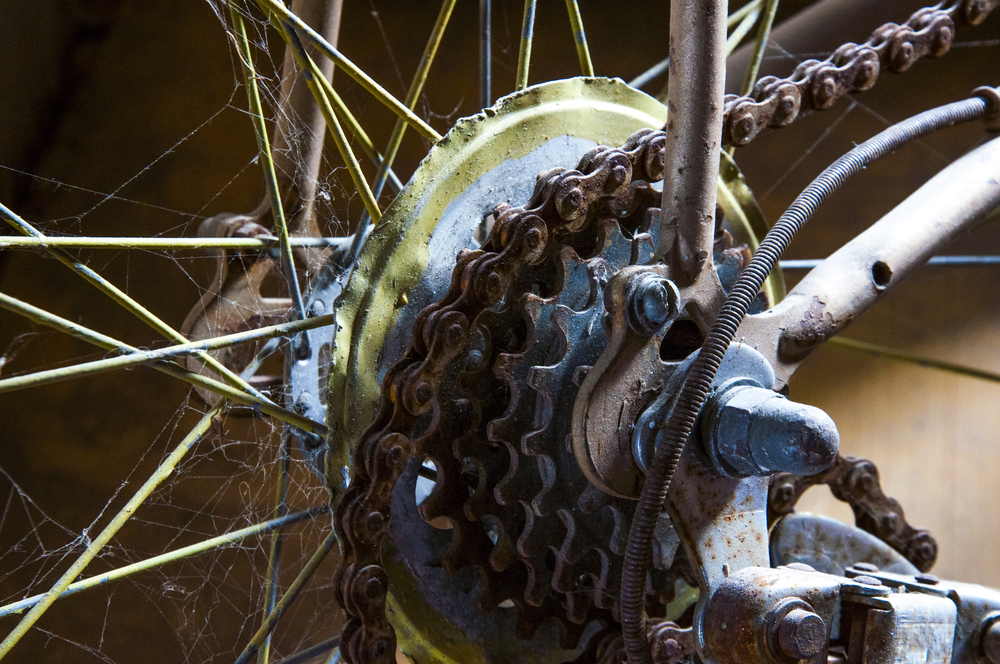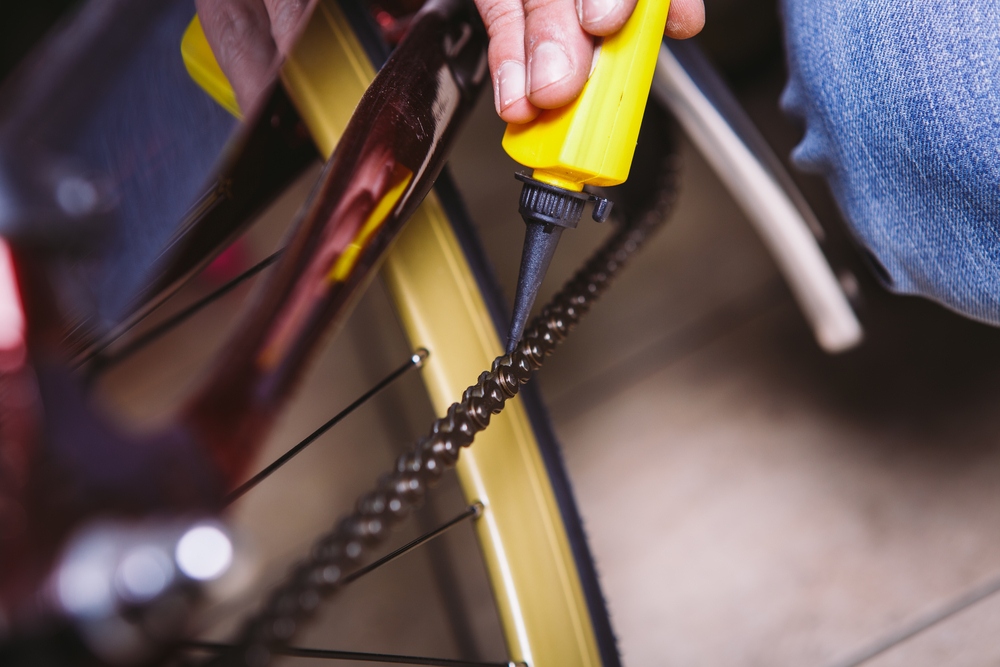A week
If you let a chain go a week without any maintenance, there should be very few noticeable inconveniences. A chain properly cared for works almost as silently as a glider in the sky, bringing nothing but the joy of a perfect ride. The pleasant whirling buzz coming from a bicycle’s drivetrain is delightful music to the ears of every cyclist.
A well-greased and maintained chain contributes not only to immaculate and rapid shifting, but also to prolonging the life of both the chainring and the cassette. Part of a regular bike chain maintenance routine is wiping off remaining chain lube from the surface its links, but the leftover lubricant still attracts dirt.
No matter how clean a chain is, it turns slightly dirty after a week of operation. This is why when you make contact with it, be it your calf, hand or trousers, it leaves a smear. Take it or leave it, this is part of cycling.

A month
A month in, the strange sound resembling the swordplay of a fork and a knife may be heard during the ride. Squeaking noises coming from down there are the cry of alarm, notifying you that the chain is in desperate need of lubrication. The longer you wait, the worse the chain’s condition will become.
Annoying screeches originate somewhat from the friction between the inner and outer link side plates and partly from the dry chain scraping against the front chainrings’ teeth. Even if the chain itself seems clean and polished, contact with some parts of the drive train might make you dirty too.
Black masses of thick, oily smear resembling dense, heavy-duty factory grease gathers in some places like in the gap between the teeth of the chainrings, the crevasses of the cassette on the rear wheel, and around the bushing of the derailleur pulley wheels. Should the chain be ridden in the rain, the most worn-out parts of it might turn orange overnight, showing evidence of early rust.
6 months
Six months later and the sound produced by most bike chains during every ride is similar to what you might hear in a theatre when all orchestra members start tuning simultaneously. The harshness of this cacophony can make you shudder.
Since the bushings, pins and rollers inside the chain links have gone completely dry, the chain gets stiff and the links might seize. Already poor shifting gets slow and inaccurate, which drives any devoted cyclist more crazy than the permanent squeals.
As most chains are usually made of steel, which is harder wearing than the alloy used for the rest of the drivetrain, the abrasion from the hardened links slowly start grinding down the teeth of the chainring and leaving its mark on the sides. Riders may experience skipped gears between shifts, something that can’t be fixed by a new cassette, fiddling with cable tension, derailleur settings or the sudden desire to perform some maintenance. It’s too late, mate.

A year
A year later and looking like something dragged in from a ship-wrecking yard, the now stiff and rusty chain may refuse to set the bike into motion at all. The good news, if you manage to persuade the bike to function, you won’t need a bell on the cycle path. Other cyclists and passersby will hear well before you approach them.
Even if it has been kept in a dry place, rust may have prevailed on most of its metal surface. Some of the links may have even fused together, creating an unusable piece of steel. Bad news for anyone who has arrived at this point, the deterioration of the drivetrain components is most likely irreversible and the lifespan of the parts has been remarkably cut.
Chain stretch
Other than neglect, old or dirty chain issues, a worn chain created by repeated tension when pedalling is also a major menace to any drivetrain. Mechanics for professional riders change the rider’s bicycle chains twice or even three times during the Tour de France. According to experts, the chain should be replaced after each 2,000 to 3,000 km of riding.
Worn chains with stretched links cause damage to the rest of the drive system. When not changed within the manufacturers recommended limits, the result is the likely replacement of any chainrings as well as the cassette sprockets. Not only will you spend approximately 5 times more on parts but, on top of that, the cost of the service will match its complexity too.
How to check for chain stretch
If you haven’t neglected chain maintenance, yet your gears do not shift properly, it’s time to check for chain stretch. But what is it exactly? Do chains actually stretch? The short answer is no, it is more of an illusion of stretch when a chain gauge, made by companies like Shimano or Park Tool, is used to measure chain wear. But why?
The links of a chain are held together by pins, bushings and rollers. The repeated action and friction of pedalling actually wears away some of this material over time. So, if you measure the distance between links of a new chain and compare it to that of an old chain, there will be difference in length.
The actual length of the whole chain has not changed, but the gap between the links has, and this difference is called the chain wear or chain stretch. Whether you keep a chain clean and regularly use a good lubricant or not, you will end up with a worn chain that needs to be replaced. There is no escaping it.
There are a few different tool versions of a chain checking tool, but they function on the same principle, it’s just how you read them that varies. Your local bike shop should have them for sale. You can get a great tutorial by watching this. As a chain is much cheaper to replace than one or more drivetrain components, so it is worth it to do your part to check your chain regularly to avoid any unnecessary expenses.
Is resurrection possible?
As long as chain wear is not a factor, and depending on how long it has been neglected, resurrection may be possible. It’s worth a try at least. Choose your favourite chain cleaning device from today’s market and combine it with a top notch chain cleaner to give yours give yours a good clean. It’s also okay to use soapy water and stiff bristled brush to remove stubborn grit and rust. An old toothbrush can come in handy to clean the rear derailleurs’ pulley wheels.
If you have one, ultrasonic cleaners are a great option as they take little to no effort, are very affective and clean with less mess too. Most chains come with a quick link, making their removal and installation a snap. When you’ve done the best you can to restore the chain’s integrity, wipe it down with a lint free cloth before allowing it to air dry.
Now it’s time for applying lube. Take your favourite chain oil and let a generous drop or two fall on each link. Yes, this will take time, but do you want to try to save it or not? When you are done, run the chain through your fingers and feel for any spots you may have missed. Let the lube sit overnight before using another lint free cloth to remove any excess. You should quickly find out if you were able to perform a miracle or not.





